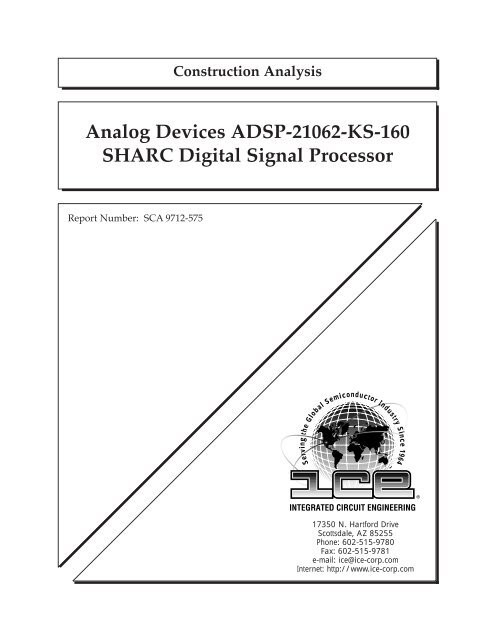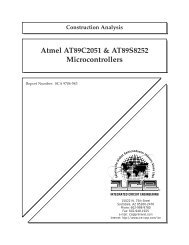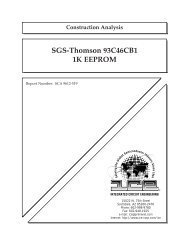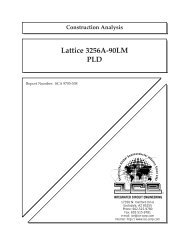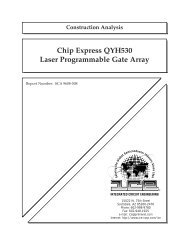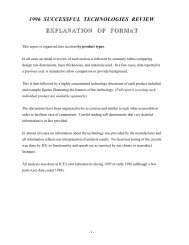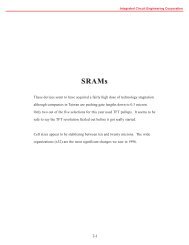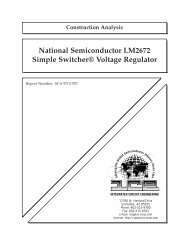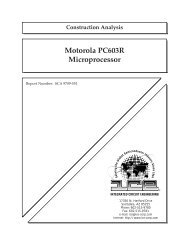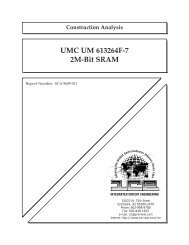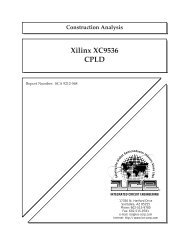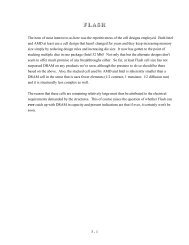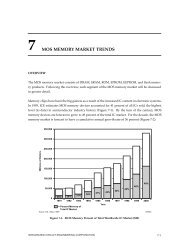ICE Shared Construction Analysis SCA 9712-575 - Smithsonian ...
ICE Shared Construction Analysis SCA 9712-575 - Smithsonian ...
ICE Shared Construction Analysis SCA 9712-575 - Smithsonian ...
Create successful ePaper yourself
Turn your PDF publications into a flip-book with our unique Google optimized e-Paper software.
<strong>Construction</strong> <strong>Analysis</strong><br />
Analog Devices ADSP-21062-KS-160<br />
SHARC Digital Signal Processor<br />
Report Number: <strong>SCA</strong> <strong>9712</strong>-<strong>575</strong><br />
Serving the Global Semiconductor Industry Since 1964<br />
17350 N. Hartford Drive<br />
Scottsdale, AZ 85255<br />
Phone: 602-515-9780<br />
Fax: 602-515-9781<br />
e-mail: ice@ice-corp.com<br />
Internet: http://www.ice-corp.com<br />
®
TITLE<br />
INDEX TO TEXT<br />
- i -<br />
PAGE<br />
INTRODUCTION 1<br />
MAJOR FINDINGS 1<br />
TECHNOLOGY DESCRIPTION<br />
Assembly 2<br />
Die Process 2 - 3<br />
ANALYSIS RESULTS I<br />
Assembly 4<br />
ANALYSIS RESULTS II<br />
Die Process and Design 5 - 7<br />
ANALYSIS PROCEDURE 8<br />
TABLES<br />
Overall Evaluation 9<br />
Package Markings 10<br />
Wirebond Strength 10<br />
Die Material <strong>Analysis</strong> 10<br />
Horizontal Dimensions 11<br />
Vertical Dimensions 12
INTRODUCTION<br />
This report describes a construction analysis of the Analog Devices ADSP-21062-KS-160<br />
SHARC Digital Signal Processor. Two devices which were packaged in 240-pin Plastic<br />
Quad Flat Packages (PQFP) were received for the analysis. The devices were date coded<br />
9641 and 9701. The majority of the analysis was performed on the device date coded 9701.<br />
Questionable Items: 1<br />
• none.<br />
Special Features:<br />
• Sub-micron gate lengths (0.5 micron).<br />
• Tungsten plugs.<br />
MAJOR FINDINGS<br />
1 These items present possible quality or reliability concerns. They should be discussed<br />
with the manufacturer to determine their possible impact on the intended application.<br />
- 1 -
Assembly:<br />
TECHNOLOGY DESCRIPTION<br />
• The devices were packaged in 240-pin Plastic Quad Flat Packages (PQFP). A<br />
copper heat slug (heatsink) was employed on the top of the package (cavity down<br />
orientation). It was internally connected to ground.<br />
• Wirebonding method: A thermosonic ball bond technique employing 1.2 mil O.D.<br />
gold wire was used.<br />
• Dicing: Sawn (full depth) dicing.<br />
• Die attach: A silver epoxy compound.<br />
Die Process<br />
• Fabrication process: Selective oxidation CMOS process employing twin-wells in an<br />
N substrate.<br />
• Die coat: No die coat was used on the devices.<br />
• Final passivation: A layer of nitride over a layer of silicon-dioxide.<br />
• Metallization: Two levels of metal defined by standard dry-etch techniques. Metal 2<br />
consisted of aluminum with a titanium-nitride cap and barrier. Metal 1 consisted of<br />
aluminum, a titanium nitride cap and barrier, and a titanium adhesion layer.<br />
Tungsten plugs were used as the vertical interconnect under both metal layers. They<br />
were lined with titanium-nitride.<br />
• Interlevel dielectric: Interlevel dielectric consisted of four layers of silicon-dioxide<br />
with a planarizing spin-on-glass (SOG) between the third and fourth layer.<br />
• Pre-metal dielectric: This dielectric consisted of a layer of reflow glass over<br />
densified oxides.<br />
- 2 -
TECHNOLOGY DESCRIPTION (continued)<br />
• Polysilicon: Two layers of polysilicon were used on the die. Poly 1 (polysilicon<br />
and tungsten silicide) was used to form redundancy fuses, all gates on the die, and<br />
word lines in the array. Poly 2 was used to form “pull-up” resistors in the cell<br />
array, and formed resistors in fuse blocks which were connected to one end of the<br />
poly 1 fuses. Both poly layers were defined by a dry-etch of good quality.<br />
• Diffusions: Implanted N+ and P+ diffusions formed the sources/drains of<br />
transistors. No silicide was present on diffusions. An LDD process was used with<br />
the oxide sidewall spacers left in place. N+ diffusions were “pushed down” at<br />
tungsten contacts.<br />
• Wells: Planar (no step in LOCOS) twin-well process in the N substrate. No epi<br />
layer.<br />
• Redundancy: Fuses consisting of poly 1 were present on the die. Passivation and<br />
interlevel dielectric cutouts were made over the fuses. One end of the fuse structure<br />
was connected to metal 1, while the other end was connected to a poly 2 resistor.<br />
Some laser blown fuses were noted.<br />
• Memory cells: The die employed a 2 Mbit SRAM array. The memory cells used a<br />
4T CMOS SRAM cell design. Metal 2 distributed GND and Vdd (via Metal 1), and<br />
formed the bit lines using metal 1 links. Metal 1 was used as “piggy-back” word<br />
lines. Poly 1 formed the word lines, select, and storage gates. Poly 2 formed “pull-<br />
up” resistors and distributed Vdd.<br />
• Both metals 1 and 2 were used in the bond pads.<br />
- 3 -
Assembly:<br />
Questionable Items: 1 None.<br />
Special Features: None.<br />
General Items:<br />
ANALYSIS RESULTS I<br />
- 4 -<br />
Figures 1 - 2<br />
• Overall package: The device was packaged in a 240-pin PQFP. A large copper heat<br />
slug (heatsink) was employed on the top of the package (cavity down orientation). It<br />
was internally connected to GND.<br />
• Wirebonding method: A thermosonic ball bond technique employing 1.2 mil gold<br />
wire was used. All bonds were well formed and placed. Bond strengths were<br />
normal as determined by wire pull tests.<br />
• Dicing: Sawn (full depth). No large chips or cracks were noted.<br />
• Die attach: A silver epoxy compound of normal quality.<br />
1 These items present possible quality or reliability concerns. They should be discussed<br />
with the manufacturer to determine their possible impact on the intended application.
Die Process and Design:<br />
Questionable Items: 1<br />
• None.<br />
Special Features:<br />
• Sub-micron gate lengths (0.5 micron).<br />
General Items:<br />
ANALYSIS RESULTS II<br />
- 5 -<br />
Figures 3 - 39<br />
• Fabrication process: Selective oxidation CMOS process employing twin-wells in an<br />
N substrate.<br />
• Process implementation: Die layout was clean and efficient. Alignment was good<br />
at all levels.<br />
• Die surface defects: None. No contamination, toolmarks or processing defects<br />
were noted.<br />
• Passivation: A layer of nitride over a layer of silicon-dioxide. Passivation coverage<br />
and edge seal were good. Integrity test indicated defect free passivation.<br />
• Metallization: Two levels of metallization were used. Metal 2 consisted of<br />
aluminum with a titanium-nitride cap and barrier. Metal 1 consisted of aluminum,<br />
titanium-nitride cap and barrier, and a titanium adhesion layer. Tungsten plugs were<br />
employed under both metal layers. The plugs were lined with titanium-nitride.<br />
• Metal patterning: All metal layers were defined by a dry etch of good quality.<br />
1 These items present possible quality concerns. They should be discussed with the<br />
manufacturer to determine their possible impact on the intended application.
ANALYSIS RESULTS II (continued)<br />
• Metal defects: None. No voiding, notching or cracking of the metal layers was<br />
found. Silicon nodules were found following removal of metal 1.<br />
• Metal step coverage: Virtually no metal thinning was noted due to the use of<br />
tungsten plugs. The tungsten plugs were nearly level with the oxide surface, so no<br />
large steps were present for the metal to cover.<br />
• Vias and contacts: Vias and contacts were defined by a dry-etch. No significant<br />
over-etching was noted.<br />
• Interlevel dielectric: Interlevel dielectric consisted of four layers of silicon-dioxide<br />
with a spin-on-glass (SOG) between the third and fourth layers to aid in<br />
planarization. No problems were noted.<br />
• Pre-metal dielectric: This dielectric consisted of a layer of reflow glass (BPSG) over<br />
densified oxide. No problems were found.<br />
.• Polysilicon: Two layers of polysilicon were employed. Poly 1 (polysilicon and<br />
tungsten silicide) formed the redundancy fuses, all gates on the die, and word lines<br />
in the array. Poly 2 was used to form resistors in the cell array and outside the fuse<br />
blocks. Definition was by a dry etch of good quality. No problems were found.<br />
• Isolation: LOCOS (local oxide isolation). No problems were noted at birdsbeak or<br />
elsewhere and no step was present at the well boundaries.<br />
• Diffusions: Implanted N+ and P+ diffusions were used for sources and drains.<br />
Oxide sidewall spacers were present to provide LDD spacing. Deep (pushed down)<br />
N+ diffusions were noted under contacts in N regions. Diffusions were not<br />
silicided. No problems were found.<br />
• Wells: Twin-wells were employed in an N substrate. No step was present at the<br />
well boundaries. No problems were noted.<br />
- 6 -
ANALYSIS RESULTS II (continued)<br />
• Buried contacts: Direct poly-to-diffusion (buried) contacts were only used in the<br />
SRAM array. No problems were found in these areas.<br />
• Redundancy: Poly 1 fuses were present along the row and column decode logic<br />
outside the SRAM array. Passivation and interlevel dielectric cutouts were made<br />
over the fuses. Laser blown fuses were noted.<br />
• Memory cells: The die employed a 2 Mbit SRAM array. The memory cells used a<br />
4T CMOS SRAM cell design. Metal 2 distributed GND and Vdd, and formed the<br />
bit lines using metal 1 links. Metal 1 was used as the “piggy-back” word lines.<br />
Poly 1 formed the word lines, select, and storage gates. Poly 2 formed “pull-up”<br />
resistors and distributed Vdd. Cell size was 3.3 x 5.7 microns (19 microns 2 ).<br />
- 7 -
PROCEDURE<br />
The devices were subjected to the following analysis procedures:<br />
External inspection<br />
X-ray<br />
Decap<br />
SEM of passivation<br />
Passivation integrity test (chemical)<br />
Wirepull test<br />
Passivation removal<br />
SEM inspection of metal 2<br />
Aluminum 2 removal and inspect<br />
Delayer to metal 1 and inspect<br />
Aluminum 1 removal and inspect barrier<br />
Delayer to polycide/substrate and inspect<br />
Die sectioning (90° for SEM) *<br />
Measure horizontal dimensions<br />
Measure vertical dimensions<br />
Die material analysis<br />
* Delineation of cross-sections is by silicon etch unless otherwise indicated.<br />
- 8 -
OVERALL QUALITY EVALUATION: Overall Rating: Good<br />
DETAIL OF EVALUATION<br />
Package integrity: G<br />
Die placement: G<br />
Die attach quality: G<br />
Wire spacing: N<br />
Wirebond placement: N<br />
Wirebond quality: G<br />
Dicing quality: G<br />
Wirebond method Thermosonic ball bonds using 1.2 mil<br />
- 9 -<br />
gold wire.<br />
Die attach method Silver-epoxy<br />
Dicing Sawn (full depth)<br />
Die surface integrity:<br />
Toolmarks (absence) G<br />
Particles (absence) G<br />
Contamination (absence) G<br />
Process defects (absence) G<br />
General workmanship G<br />
Passivation integrity G<br />
Metal definition G<br />
Metal integrity G<br />
Metal registration G<br />
Contact coverage G<br />
Contact registration G<br />
G = Good, P = Poor, N = Normal, NP = Normal/Poor
Sample 1<br />
PACKAGE MARKINGS<br />
TOP<br />
- 10 -<br />
Sample 2<br />
(LOGO) ANALOG DEV<strong>ICE</strong>S (LOGO) ANALOG DEV<strong>ICE</strong>S<br />
ADSP-21062 ADSP-21062<br />
9641 KS-160 9701 KS-160<br />
ED/C15598.00-2.1 (SHARC LOGO) ED/C16005.00-2.1 (SHARC<br />
LOGO)<br />
BOTTOM<br />
WAFER H WAFER H<br />
HONG KONG HONG KONG<br />
WIREPULL TEST<br />
Sample 2<br />
# of wires tested: 25<br />
Bond lifts: 0<br />
Force to break - high: 9g<br />
- low: 5.25g<br />
- avg.: 7.45g<br />
- std. dev.: 1.0<br />
DIE MATERIAL IDENTIFICATION<br />
Overlay passivation: Nitride over silicon-dioxide.<br />
Metallization 2: Aluminum with a titanium-nitride cap and<br />
barrier.<br />
Interlevel dielectric: Multiple layers of silicon-dioxide including<br />
SOG.<br />
Metallization 1: Aluminum with a titanium-nitride cap and<br />
barrier, on a titanium adhesion layer.<br />
Plugs: Tungsten, lined with titanium-nitride.<br />
Pre-metal glass: BPSG reflow glass on densified oxide.<br />
Silicide (Poly 1): Tungsten.
HORIZONTAL DIMENSIONS<br />
Die size: 11.9 x 14.9 mm (468 x 586 mils)<br />
Die area: 177 mm 2 (274,248 mils 2 )<br />
Min pad size: 0.11 x 0.11 mm (4.4 x 4.4 mils)<br />
Min pad window: 0.09 x 0.09 mm (3.7 x 3.7 mils)<br />
Min pad space: 40 microns<br />
Min metal 2 width: 0.8 micron<br />
Min metal 2 space: 1.0 micron<br />
Min metal 2 pitch: 1.8 micron (uncontacted)<br />
Min metal 1 width: 0.6 micron<br />
Min metal 1 space: 0.7 micron<br />
Min metal 1 pitch: 1.3 micron (uncontacted)<br />
Min via: 0.45 micron<br />
Min contact: 0.5 micron<br />
Min polycide width: 0.5 micron<br />
Min polycide space: 0.7 micron<br />
Min gate length * - (N-channel): 0.5 micron<br />
- (P-channel): 0.5 micron<br />
Min LOCOS: 0.8 micron<br />
SRAM cell size: 19.0 microns 2<br />
SRAM cell pitch: 3.3 x 5.7 microns<br />
* Physical gate length.<br />
- 11 -
VERTICAL DIMENSIONS<br />
Die thickness: 0.45 mm (18 mils)<br />
Layers<br />
Passivation 2: 0.6 micron<br />
Passivation 1: 0.15 micron<br />
Metal 2 - cap: 0.04 micron (approx.)<br />
- aluminum: 0.7 micron<br />
- barrier: 0.09 micron<br />
- plugs: 0.8 - 1.0 micron<br />
Interlevel dielectric - glass 4: 0.5 micron (average)<br />
- glass 3: 0.15 micron (average)<br />
- glass 2: 0.35 - 0.75 micron<br />
- glass 1: 0.15 micron (average)<br />
Metal 1 - cap: 0.15 micron (approx.)<br />
- aluminum: 0.5 micron<br />
- barrier: 0.1 micron<br />
- plugs: 0.5 - 1.0 micron<br />
Pre-metal glass: 0.65 micron<br />
Polycide - silicide: 0.1 micron<br />
- poly: 0.13 micron<br />
Local oxide: 0.4 micron<br />
N+ S/D diffusion: 0.2 micron<br />
P+ S/D diffusion: 0.2 micron<br />
N-well: 2.5 microns (approx.)<br />
P-well: 2.0 microns (approx.)<br />
- 12 -
INDEX TO FIGURES<br />
ASSEMBLY Figures 1 - 2<br />
DIE LAYOUT AND IDENTIFICATION Figures 3 - 6<br />
PHYSICAL DIE STRUCTURES Figures 7 - 39<br />
REDUNDANCY FUSES Figures 24 - 25<br />
COLOR DRAWING OF DIE STRUCTURE Figure 26<br />
SRAM MEMORY CELL STRUCTURES Figures 27 - 35<br />
CIRCUIT LAYOUT AND I/O Figure 36 - 39<br />
- ii -
Analog Devices ADSP-21062-KS-160<br />
Integrated Circuit Engineering Corporation<br />
Figure 1. Package photographs of the Analog Devices ADSP-21062-KS-160<br />
SHARC Digital Signal Processor. Mag. 2.5x.
Analog Devices ADSP-21062-KS-160<br />
PIN 1<br />
top<br />
Figure 2. X-ray view of the package. Mag. 3x.<br />
Integrated Circuit Engineering Corporation
Analog Devices ADSP-21062-KS-160<br />
Integrated Circuit Engineering Corporation<br />
Figure 3. Portion of the Analog Devices ADSP-21062-KS-160 die. Mag. 26x.
Analog Devices ADSP-21062-KS-160<br />
Integrated Circuit Engineering Corporation<br />
Figure 3a. Portion of the Analog Devices ADSP-21062-KS-160 die. Mag. 26x.
Analog Devices ADSP-21062-KS-160<br />
Integrated Circuit Engineering Corporation<br />
Figure 3b. Portion of the Analog Devices ADSP-21062-KS-160 die. Mag. 26x.
Analog Devices ADSP-21062-KS-160<br />
Integrated Circuit Engineering Corporation<br />
Figure 3c. Remaining portion of the Analog Devices ADSP-21062-KS-160 die. Mag.<br />
26x.
Analog Devices ADSP-21062-KS-160<br />
Figure 4. Optical views of die markings. Mag. 500x.<br />
Integrated Circuit Engineering Corporation
Analog Devices ADSP-21062-KS-160<br />
Figure 5. Optical views of die corners. Mag. 80x.<br />
Integrated Circuit Engineering Corporation
Analog Devices ADSP-21062-KS-160<br />
METAL 2<br />
Integrated Circuit Engineering Corporation<br />
SLOT<br />
Figure 6. Optical views illustrating a slotted bus line and mask revision numbers.<br />
Mag. 400x.
Analog Devices ADSP-21062-KS-160<br />
EDGE OF<br />
PASSIVATION<br />
Mag. 1200x<br />
METAL 2<br />
N+<br />
SUBSTRATE<br />
Mag. 6400x<br />
EDGE OF<br />
PASSIVATION<br />
METAL 1<br />
Figure 7. SEM section views of the die edge seal.<br />
Integrated Circuit Engineering Corporation
Analog Devices ADSP-21062-KS-160<br />
N+ S/D<br />
LOCOS<br />
METAL 1<br />
PASSIVATION 2<br />
PASSIVATION 1<br />
PASSIVATION 2<br />
POLY 1 GATE<br />
PASSIVATION 1<br />
SOG<br />
W PLUG<br />
W PLUG<br />
N+ S/D<br />
METAL 2<br />
POLY 1 GATE<br />
Figure 8. SEM section views illustrating general structure. Mag. 13,000x.<br />
Integrated Circuit Engineering Corporation<br />
METAL 1<br />
METAL 2<br />
LOCOS
Analog Devices ADSP-21062-KS-160<br />
Mag. 4800x<br />
Mag. 9600x<br />
Figure 9. SEM views illustrating final passivation. 60°.<br />
Integrated Circuit Engineering Corporation
Analog Devices ADSP-21062-KS-160<br />
PASSIVATION 2<br />
METAL 2<br />
INTERLEVEL DIELECTRIC<br />
METAL 1<br />
Mag. 26,000x<br />
ALUMINUM 2<br />
TiN BARRIER<br />
Mag. 52,000x<br />
TIN CAP<br />
Figure 10. SEM section views illustrating metal 2 line profiles.<br />
Integrated Circuit Engineering Corporation<br />
PASSIVATION 1
Analog Devices ADSP-21062-KS-160<br />
METAL 2<br />
METAL 2<br />
VIAS<br />
Figure 11. Topological SEM views of metal 2 patterning. 0°.<br />
Integrated Circuit Engineering Corporation<br />
Mag. 3250x<br />
Mag. 6500x<br />
Mag. 6500x
Analog Devices ADSP-21062-KS-160<br />
TiN CAP<br />
METAL 2<br />
TiN BARRIER<br />
TiN BARRIER<br />
ALUMINUM 2<br />
W PLUG<br />
Integrated Circuit Engineering Corporation<br />
Mag. 12,400x<br />
Mag. 26,000x<br />
Mag. 40,000x<br />
Figure 12. Perspective SEM views of metal 2 step coverage, barrier, and plug. 60°.
Analog Devices ADSP-21062-KS-160<br />
SOG<br />
INTERLEVEL<br />
DIELECTRIC<br />
SOG<br />
W PLUG<br />
LOCOS<br />
W PLUG<br />
PASSIVATION 2<br />
METAL 2<br />
METAL 1<br />
METAL 2<br />
W PLUG<br />
METAL 1<br />
METAL 2<br />
METAL 1<br />
POLY 1<br />
INTERLEVEL DIELECTRIC<br />
Figure 13. SEM section views of typical vias.<br />
Integrated Circuit Engineering Corporation<br />
Mag. 13,000x<br />
Mag. 26,000x<br />
Mag. 26,000x
Analog Devices ADSP-21062-KS-160<br />
INTERLEVEL DIELECTRIC<br />
TiN CAP<br />
ALUMINUM 1<br />
TiN BARRIER<br />
METAL 2<br />
METAL 1<br />
Mag. 26,000x<br />
Mag. 52,000x<br />
Figure 14. SEM section views of metal 1 line profiles.<br />
Integrated Circuit Engineering Corporation
Analog Devices ADSP-21062-KS-160<br />
METAL 1<br />
CONTACT<br />
POLY<br />
METAL 1<br />
METAL 1<br />
Figure 15. Topological SEM views of metal 1 patterning. Mag. 6500x, 0°.<br />
Integrated Circuit Engineering Corporation<br />
VIA
Analog Devices ADSP-21062-KS-160<br />
TiN BARRIER<br />
METAL 1<br />
TiN CAP<br />
ALUMINUM 1<br />
Figure 16. Perspective SEM views of metal 1 step coverage. 60°.<br />
Integrated Circuit Engineering Corporation<br />
Mag. 6500x<br />
Mag. 10,000x<br />
Mag. 30,000x
Analog Devices ADSP-21062-KS-160<br />
Si<br />
TiN BARRIER<br />
Mag. 10,000x<br />
TiN BARRIER<br />
W PLUG<br />
Mag. 40,000x<br />
Figure 17. Perspective SEM views of metal 1 barrier and plugs. 60°.<br />
Integrated Circuit Engineering Corporation
Analog Devices ADSP-21062-KS-160<br />
LOCOS<br />
LOCOS<br />
W PLUG<br />
W PLUG<br />
METAL 1<br />
W PLUG<br />
POLY 1<br />
LOCOS<br />
METAL 1<br />
METAL 1<br />
Ti ADHESION<br />
LAYER<br />
Integrated Circuit Engineering Corporation<br />
Figure 18. SEM section views illustrating typical metal 1 contacts. Mag. 26,000x.<br />
P+<br />
N+
Analog Devices ADSP-21062-KS-160<br />
POLY<br />
N+ P+<br />
Figure 19. Topological SEM views of poly 1 patterning. 0°.<br />
Integrated Circuit Engineering Corporation<br />
Mag. 3200x<br />
Mag. 3200x<br />
Mag. 6500x
Analog Devices ADSP-21062-KS-160<br />
LOCOS<br />
Mag. 9000x<br />
POLY 1 GATE<br />
DIFFUSION<br />
POLY 1<br />
Mag. 40,000x<br />
Figure 20. Perspective SEM views of poly 1 coverage. 60°.<br />
Integrated Circuit Engineering Corporation
Analog Devices ADSP-21062-KS-160<br />
PRE-METAL GLASS<br />
POLY 1 GATE<br />
REFLOW GLASS<br />
POLY 1 GATE<br />
W SILICIDE<br />
POLY 1<br />
GATE OXIDE<br />
N+ S/D<br />
Figure 21. SEM section views of typical transistors. Mag. 52,000x.<br />
Integrated Circuit Engineering Corporation<br />
P+ S/D<br />
SIDEWALL SPACER<br />
N-channel<br />
P-channel<br />
glass etch
Analog Devices ADSP-21062-KS-160<br />
POLY 1<br />
LOCOS<br />
Figure 22. SEM section view of typical birdsbeak. Mag. 52,000x.<br />
P-WELL<br />
P+<br />
LOCOS<br />
N- SUBSTRATE<br />
METAL 1<br />
N+<br />
N- SUBSTRATE<br />
DENSIFIED OXIDE<br />
GATE OXIDE<br />
P-WELL<br />
Figure 23. Section views illustrating well structure.<br />
Integrated Circuit Engineering Corporation<br />
Mag. 800x<br />
Mag. 6500x
Analog Devices ADSP-21062-KS-160<br />
BLOWN FUSE<br />
INTACT FUSE<br />
LASER BLOWN FUSE<br />
Figure 24. Optical and SEM views of typical fuses.<br />
Integrated Circuit Engineering Corporation<br />
Mag. 800x<br />
Mag. 800x<br />
Mag. 1600x
Analog Devices ADSP-21062-KS-160<br />
POLY 2<br />
CUTOUT<br />
POLY 1 FUSE<br />
PASSIVATION<br />
POLY 1 FUSE<br />
CUTOUT<br />
PASSIVATION<br />
METAL 2<br />
METAL 1<br />
LOCOS<br />
Figure 25. Perspective and cross-section SEM views of typical fuses.<br />
Integrated Circuit Engineering Corporation<br />
Mag. 4800x, 60°<br />
Mag. 6500x<br />
Mag. 13,000x
,,,<br />
,,,<br />
,,,<br />
METAL 1<br />
,,<br />
,,<br />
,,<br />
,,,<br />
,,,<br />
,,,<br />
,,<br />
,,<br />
,,<br />
,,,<br />
,,,<br />
,,,<br />
,,,,,,,,,,<br />
,,,,,,,,,,<br />
,,,,,,,,,,<br />
W PLUG<br />
NITRIDE PASSIVATION<br />
METAL 2<br />
INTERLEVEL DIELECTRIC<br />
PRE-METAL GLASS<br />
GATE OXIDE<br />
N+ S/D<br />
P-WELL<br />
N SUBSTRATE<br />
GLASS PASSIVATION<br />
W SILICIDE<br />
POLY 1<br />
SOG<br />
LOCAL OXIDE<br />
P+ S/D<br />
Orange = Nitride, Blue = Metal, Yellow = Oxide, Green = Poly,<br />
Red = Diffusion, and Gray = Substrate<br />
Figure 26. Color cross section drawing illustrating device structure.<br />
DENSIFIED OXIDE<br />
,,, ,,,,<br />
,,, ,,,,<br />
,,,,<br />
N-WELL<br />
Analog Devices ADSP-21062-KS-160<br />
Integrated Circuit Engineering Corporation
Analog Devices ADSP-21062-KS-160<br />
Integrated Circuit Engineering Corporation<br />
metal 2<br />
metal 1<br />
poly<br />
Figure 27. Perspective SEM views of the SRAM cell array. Mag. 5000x, 60°.
Analog Devices ADSP-21062-KS-160<br />
BIT<br />
BIT<br />
GND<br />
BIT<br />
BIT<br />
“PIGGYBACK” WORD LINE<br />
WORD<br />
GND<br />
Integrated Circuit Engineering Corporation<br />
metal 2<br />
metal 1<br />
poly<br />
Figure 28. Perspective SEM views of the SRAM cell array. Mag. 10,000x, 60°.<br />
GND
Analog Devices ADSP-21062-KS-160<br />
POLY 2<br />
RESISTOR<br />
POLY 1<br />
INTERLEVEL<br />
CONTACT<br />
POLY 1<br />
WORD LINE<br />
Figure 29. Detailed SEM views of the SRAM cell structures (delayered).<br />
Mag. 42,000x, 60°.<br />
Integrated Circuit Engineering Corporation<br />
POLY 2<br />
SELECT<br />
GATE<br />
POLY 1
Analog Devices ADSP-21062-KS-160<br />
BIT<br />
BIT<br />
GND<br />
“PIGGYBACK” WORD LINE<br />
WORD LINE<br />
Integrated Circuit Engineering Corporation<br />
metal 2<br />
metal 1<br />
poly<br />
Figure 30. Topological SEM views of the SRAM cell array. Mag. 3200x, 0°.<br />
GND
Analog Devices ADSP-21062-KS-160<br />
BIT<br />
BIT<br />
“PIGGYBACK”<br />
WORD LINE<br />
metal 2<br />
metal 1<br />
Integrated Circuit Engineering Corporation<br />
Figure 31. Detailed topological SEM views of an SRAM cell. Mag. 13,000x, 0°.<br />
GND<br />
BIT<br />
BIT<br />
GND
Analog Devices ADSP-21062-KS-160<br />
BIT<br />
WORD<br />
BIT<br />
1<br />
BIT 1<br />
2<br />
3<br />
unlayered<br />
R1 R2<br />
Figure 32. Detailed topological SEM view and schematic of an SRAM cell.<br />
Mag. 13,000x, 0°.<br />
R1<br />
4<br />
4<br />
3<br />
R2<br />
2<br />
Integrated Circuit Engineering Corporation<br />
GND<br />
BIT<br />
V DD<br />
GND
Analog Devices ADSP-21062-KS-160<br />
POLY 2<br />
METAL 1 LINK<br />
N+ S/D<br />
W PLUG<br />
METAL 2 BIT LINE<br />
METAL 2 BIT LINE<br />
METAL 1 LINK<br />
METAL 1 LINK<br />
POLY 1 SELECT GATE<br />
N+ S/D<br />
W PLUG<br />
W PLUG<br />
POLY 1 STORAGE GATE<br />
Figure 33. SEM section views of an SRAM cell (parallel to bit line).<br />
Integrated Circuit Engineering Corporation<br />
Mag. 13,000x<br />
Mag. 20,000x<br />
Mag. 26,000x
Analog Devices ADSP-21062-KS-160<br />
N+ S/D<br />
POLY 2 “PULL-UP”<br />
RESISTOR<br />
GATE OXIDE<br />
POLY 1<br />
POLY 2<br />
POLY 1 SELECT<br />
GATE<br />
GATE OXIDE<br />
POLY 1 STORAGE<br />
GATE<br />
N+ S/D<br />
Figure 34. SEM section views of SRAM cell details (parallel to bit line).<br />
Integrated Circuit Engineering Corporation<br />
LOCOS<br />
Mag. 35,000x<br />
Mag. 52,000x<br />
Mag. 52,000x
Analog Devices ADSP-21062-KS-160<br />
METAL 2 BIT LINE<br />
BIT LINE CONTACT<br />
POLY 1 WORD / SELECT LINE<br />
Mag. 13,000x<br />
POLY 1 WORD / SELECT LINE<br />
GATE OXIDE<br />
LOCOS<br />
Mag. 26,000x<br />
Integrated Circuit Engineering Corporation<br />
Figure 35. SEM section views of the SRAM cell array (perpendicular to bit line).
Analog Devices ADSP-21062-KS-160<br />
intact<br />
unlayered<br />
Figure 36. Optical views of typical I/O circuitry. Mag. 400x.<br />
Integrated Circuit Engineering Corporation
Analog Devices ADSP-21062-KS-160<br />
Au<br />
Au<br />
POLY 1<br />
Mag. 3200x<br />
METAL 1<br />
Mag. 13,000x<br />
LOCOS<br />
Figure 37. SEM section views illustrating wirebond interface.<br />
Integrated Circuit Engineering Corporation<br />
EDGE OF PASSIVATION
Analog Devices ADSP-21062-KS-160<br />
METAL 1<br />
SOG<br />
P+ S/D<br />
P+ S/D<br />
METAL 2<br />
METAL 1<br />
Mag. 13,000x<br />
SOG<br />
POLY 1 GATE<br />
Mag. 26,000x<br />
Figure 38. SEM section views of P-channel I/O circuitry.<br />
Integrated Circuit Engineering Corporation<br />
POLY 1 GATE
Analog Devices ADSP-21062-KS-160<br />
N- channel<br />
P-channel<br />
Integrated Circuit Engineering Corporation<br />
Figure 39. SEM section views illustrating guardbands at the edge of the I/O circuitry.<br />
Mag. 6500x.


